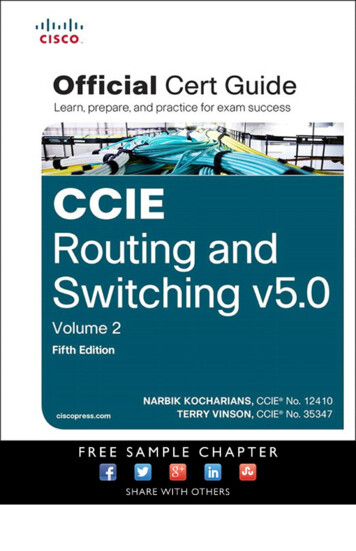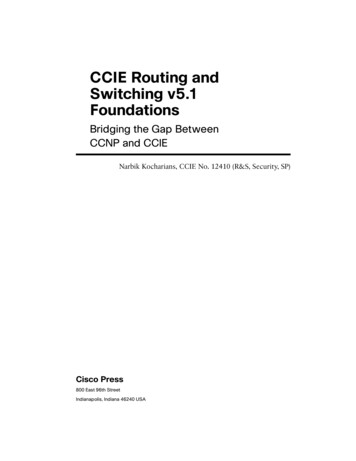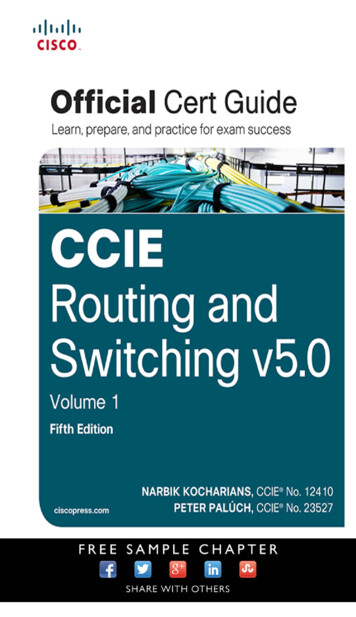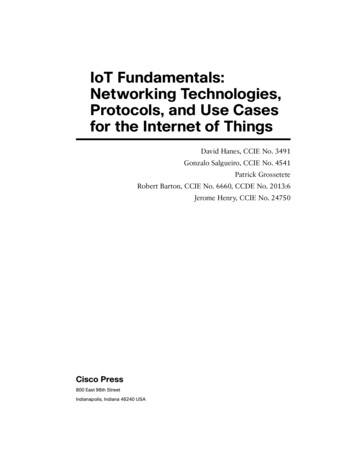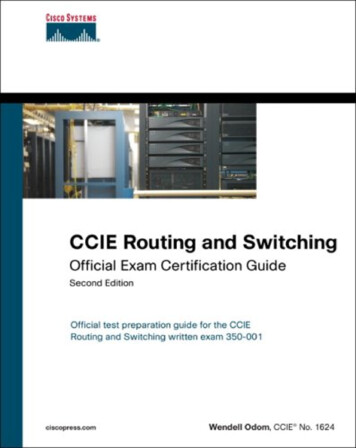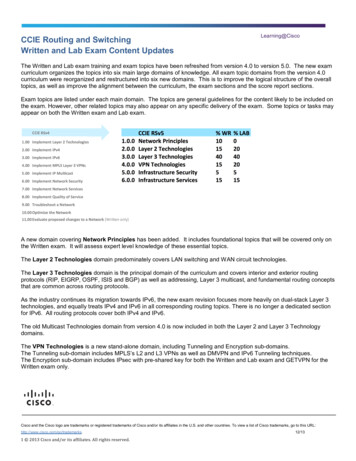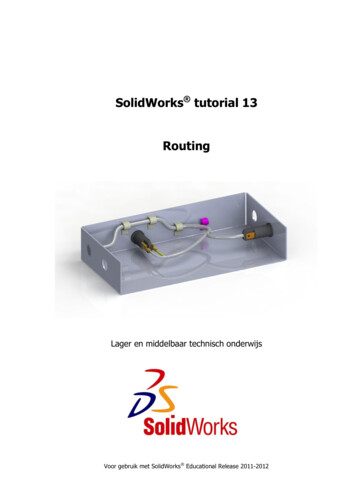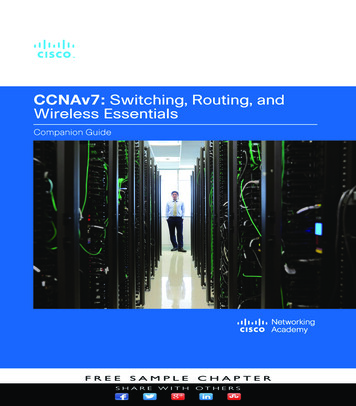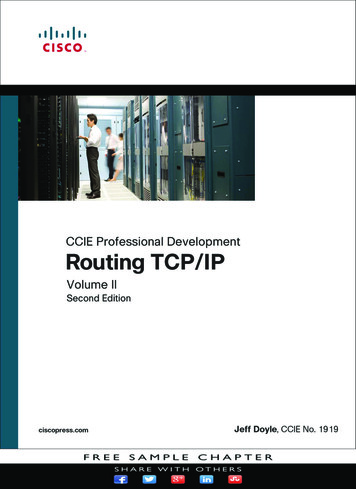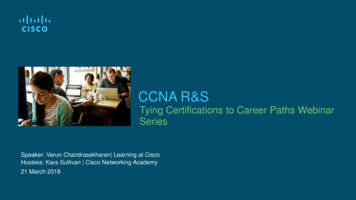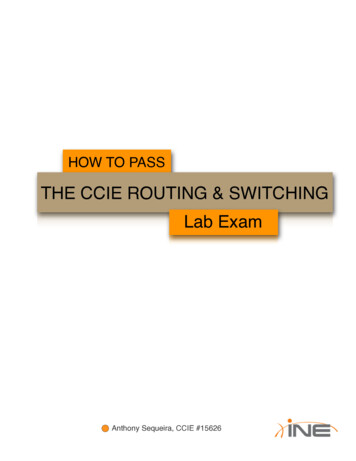
Transcription
HOW TO PASSTHE CCIE ROUTING & SWITCHINGLab ExamAnthony Sequeira, CCIE #15626
1GettingStarted
Getting Started3Passing the CCIE R&S Version 4 lab exam proves to be the most challengingendeavor many have sought out to accomplish. I find that it requires great strengthin four cornerstones for success. These cornerstones are: Technical Knowledge Strategy Psychology Physical WellnessThe first initial mistake students tend to make is to focustoo much on the technical knowledge piece as theycompletely disregard the others. While this paper willrecommend you start with an analysis of your technicalskills in the various exam areas, you should also beginthinking about how you will approach your study and labexam strategies, how you will keep the properINE TIPNo matter where you arein your journey, theproducts and servicesprovided in the INEVersion 4.0 TrainingProgram will ensure thatyou will complete yourjourney.psychological mindset for passing the exam, and how youwill maintain your physical wellness throughout the process.When you first start your journey, you should assess your strengths and weaknessesin relation to the technologies and topics covered in the CCIE Lab Exam. It is vitalthat you are honest with yourself when making this assessment. For this importantfirst step, you should examine each topic provided in our Expanded Blueprint for theCCIE R&S Version 4 exam and rate yourself on a scale of 1 to 5. 1 indicated thatyou have never heard of the technology or topic before, while 5 indicates you havemastered the Theory, Configuration, Verification, and Troubleshooting of that topic.Now that you have gone through the checklist, you know where you are at and youknow where you are going. Some will have a head start in this journey through onthe job networking experience and some will be taking their first step. No matterwhere you are in your journey, the products and services provided in the INE Version4.0 Training Program will ensure that you will complete your journey.
Getting Started4Do not look for "short cuts" on your journey. Stick to the path we have outlinedfor you here and it will help you not only in your journey to become a CCIE but alsoin your career as a networking engineer. During your journey stay away from cheatsheets, brain dumps, gotcha lists, etc. The material you have access to here,combined with the Cisco Documentation, is everything you need to complete yourjourney. All of the products and services are designed as an important step in yourjourney. The INE's Version 4.0 Program is not just a bunch of products and servicesthat are bundled together with no rhyme or reason. All of the products and servicesare developed by the elite instructor team here at INE. We put our names on thefront of everything we offer and personally stand behind our products and services.You may get discouraged at times during your journey and think that it may not beworth it. Don't give up or stray from your path and you will complete the journey ashundreds of our customers have done before you.The average candidate attempts the CCIE lab 2.7 times before passing. You want tohave a personal goal to pass the lab the first time or the second at the latest. If youhave properly followed the path we have given you this should be an obtainablegoal.I would like to add a couple more items here before you begin. As I said earlier, youmust be honest in your assessment of your knowledge. There isn't a problem inthinking you are knowledgeable about a topic but there is a problem when you thinkyou are more knowledgeable then you really are. I've personally seen people takethe CCIE Lab 7 or 8 times before passing because of this single problem. Theywould never step back to assess where they were and why they failed. Theybelieved they just needed more practice labs and would buy every workbook on themarket. You do not want to fall into this trap. You want to pass the CCIE lab exam asa byproduct of learning the technologies and topics covered. You do not want topass because you can remember seeing a scenario in a practice lab you did.Congratulations on beginning your journey!
2ThreeStepLearningProcess
Three Step Process6The recommended learning process you should take is what I define as a three steplearning process. The first step is to get an understanding of what the technology orfeature does and why it was implemented. This step should be done from a vendorneutral point of view if possible. This can be done by utilizing the CiscoDocumentation, our Volume 1 Workbook, a Core Knowledge Simulator Link, thevarious books and white papers, or the RFCs freely available on the Internet.INE TIP1. Understand theTechnology2. Learn theImplementation3. Experience theThe second step is to learn how Cisco hasimplemented the particular technology or feature. Youcan do this by using the numerous configurationexamples, tech tips, and documentation available onthe Internet and Cisco's website along with CiscoPress books. Do not underestimate the wealth ofinformation available in the Cisco Documentation.TechnologyNow that you have an understanding of the why andthe how, it's time to take the third step by gainingexperience with the technology or feature through hands on practice. Althoughanything is pretty much theoretically possible, you can not expect to pass the CCIELab Exam without hundreds of hours of hands-on practice and/or real worldexperience on the routers and switches. Many students report that this can add upto 400 to 700 hours of command line practice on the devices. In the CCIE lab theywill be trying to test your experience and the main way they test experience is byseeing how familiar you are with the technologies and topics. Generally speaking,someone who is more familiar will also be faster. By faster I do not mean that theycan type faster, but that they can do a task faster than someone without theequivalent experience. So do not worry about your keyboard typing speed if it is notthe fastest.If we break these three steps down into time frames, the first step would consumeabout 15% of total time, the second step about 20%, and the last step about 65% oftotal time. This means that for every one hour of reading about a technology ortopic, you should expect to spend two hours doing hands-on practice.
Three Step Process7Recommended Reading Prior to StartingAt the CCIE candidate stage, you are assumed to have at least a CCNP level ofknowledge and/or experience before starting your lab preparation. Most of thisknowledge can also be found in the books in our recommended reading section.The books below are designed to ensure that you solidify your foundation in generalnetworking. As with a real building, the foundation you put down now will determinethe height of the building that can be built upon it in the future. Take the time to readthese books and solidify your foundation.Internetworking with TCP/IP, Vol 1 by Douglas E. ComerThe Protocols (TCP/IP Illustrated, Volume 1) by W. Richard StevensBased on your personal style of learning, you can use eitherone of these books as a starting point. Ideally you would readboth, but just one is sufficient.Note: If you select "The Protocols" by Stevens you can skipchapter 29 (NFS: Network File System). If you selectInternetworking with TCP/IP by Comer (which is my personalchoice), you should read it cover to cover.Another excellent text to consider is:Interconnections: Bridges, Routers, Switches, and!Internetworking Protocols (2nd Edition) by RadiaPerlmanNote: With this text, you can safely skip chapter 4 (SourceRoute Bridges) and chapter 7 (Connection-oriented Nets: X.25and ATM).
Three Step Process8CCIE Routing & Switching Written BootcampEven if a candidate has passed their written examStep One:Learnrecently, most students like to begin here. This funand interactive, self-paced bootcamp is another toolthat can be used to identify major weaknesses intheoretical understanding, and patch theseweaknesses quickly and efficiently. Students alsoreport the tremendous value of this tool for the CoreKnowledge portion of the R&S Lab examination.CCIE Routing & Switching Audio BootcampThe audio class is designed to ensure that you have asolid understanding of the technologies that will becovered in the CCIE Lab Exam. Again, most studentsreport they like listening to this prior to starting any ofthe other material.After listening to these modules, if you feel you havesome "gaps" in your basic understanding of thetechnologies covered, you should fallback and fill inthese gaps using the other materials below from INE.CCIE Routing & Switching Advanced Technologies Class-on-DemandThe Advanced Technologies CoD is an amazing video series that is organized byspecific technology topic for the Version 4 R&S exam. It is not uncommon for peopleto view sections that they are weak on more than once so if you feel you did not fullyunderstand a section, be sure to rewind the CoD and go back over the section.CCIE Routing & Switching Lab Workbook Volume I - Technology-Based LabsUse the technology labs of Volume 1 as a means to get an understanding of theimplementation for any technologies or features you are not familiar with. Theselabs are not meant to be done as a whole, but more as a way to fill in any gaps inyour knowledge base. After you have finished the required section of this Workbook,you should have a good understanding of the technologies and topics covered in theCCIE Lab Exam. You will have also gained a good understanding of theconfiguration and verification process.
Three Step Process9CCIE Routing & Switching Lab Workbook Volume IIThe goal for this part of your journey is to solidify yourknowledge while at the same time expanding yourknowledge by hands on practice. It is important that youStep Two:Practicehave the knowledge discussed earlier as you will have amuch harder time with the labs and will not receive the fullbenefit of them.Start off with the IEWB-RS Volume II Workbook labs 1, 2, 3, and 4. Treat these asmore warm-up labs as opposed to true practice labs. What is meant by "warm-up" isuse these labs to get familiar and comfortable with doing full eight hour labs and notbe concerned if they take you more than 8 hours to complete. Ensure that you gainthe knowledge and experience that is conveyed in these labs and not worry about apass or fail at this point.At this point, you may recognize that speed is goingto be a major issue for you. Remember, you do needto become extremely fast and efficient atconfiguration, verification, and troubleshooting inorder to pass the Version Routing & Switching exam.In order to help you to build speed and accuracy inyour core configurations of full reachability in the lab exam, the Volume 3 workbookwas created.CCIE Routing & Switching Interactive Video Companion Seriesfor Lab Workbook Volume IITo enhance the bestselling Volume 2 Workbook, INE created an interactive, selfpaced, video companion to the product. This compliment to Volume 2 providesdetailed walkthroughs of solutions and verifications of select Volume 2 labs, and alsocreates new content for students to practice with that includes Core Knowledgepractice, Configuration Speed Drills, DOC-CD Speed Drills, and AdvancedTroubleshooting exercises.
Three Step Process10CCIE Routing & Switching Lab WorkbookVolume IV - Troubleshooting LabsFor many students, just troubleshooting their ownmisconfigurations is not enough to feel confident andready for the difficult Troubleshooting section of theactual CCIE Routing & Switching lab exam. TheStep Two:PracticeVolume 4 workbook was created to address thisissue. Students should consider completing thisworkbook, or only portions of it, if they feel moreproficient in this area.CCIE Routing & Switching 6-Day BootcampThis bootcamp allows students to practice and review all aspects of theirpreparedness as they work through sample Core Knowledge, TroubleshootingTickets, and Configuration tasks. Students have near round the clock access to atop-rated INE instructor, and students also have 24x7 equipment access.Bootcamps available in multiple locations!
Three Step Process11CCIE Routing & Switching Lab WorkbookVolume III - Core Technology LabsStep Three:RefineYou should use this workbook to ensure you are veryfast, accurate, and efficient with your configuration ofprotocols in the lab exam that provide corereachability. These configurations, if not mastered, willcertainly fail a student in their attempt.CCIE Routing & Switching 6-Day Mock Lab WorkshopThis extension to the 6-Day Bootcamp for R&S allows you to complete 4 fullgraded mock labs in the presence of an INE instructor. Two full days of lecture areincluded in this workshop to review specific labtasks and discuss the finer and critical points oflab strategy, technology. psychology, and physicalwellness.CCIE Routing & Switching Graded Mock LabExamsNow with a good portion of the journey behindyou, it is time to take the first two mock labs. Thereason you should take two labs over taking just one is to ensure that you can getan accurate assessment. It will depend on the results of your first two mock labs asto how you will move forward.If you scored 60% or below on both mock labs this is another point in your journeythat you should step back and reassess your knowledge and readiness for the reallab. Examine your detailed results report and try to figure out why you scored so low.Here are some of the more common reasons people have a hard time with the mocklabs:1. Do not understand the technologies and topics covered2. Had problems understanding the requirements from the wording given in thetasks3. Made too many little mistakes4. Overwhelmed with all of the tasks and did not have time to complete them all
Three Step Process12If you failed because of the first issue sited above,you definitely should step back and fill in the gapsyou have in your knowledge. Do not go any furtherStep Three:with training until you have done this. Every time Iteach the 6 Day R&S Bootcamp class I learnRefinesomething new, so I can pretty much guaranteethat if you watch the CoD or attend the class againyou will benefit from it. Remember that we do not require you to fail the real labbefore you can audit our classes again. Also, do not hesitate to go back and redo acouple of the Volume 2 Workbook labs that you have done before. You may besurprised at what you can still learn from them.If you had problems with task interpretation (number 2 above), it could be a coupleof issues. First off you may not understand the technologies and topics enough tograsp the wording of the tasks. If you understand the technologies and topics youshould be able to complete the task. Secondly you may be "over thinking" the tasks.Do what the task is asking and nothing more. Do try to apply real world logic ordesign to the task. Also do not add in "what if's". This means do not worry about“what if” this router goes down or "what if" the Frame Relay circuit is down. If theproctors are looking for redundancy to be taken into consideration they will ask for it.The little mistakes are what personally get me (forgetting to no shut an interface,etc). As you become more of an "expert", you will make fewer mistakes and solvethe ones that you do make quickly. You will always make little mistakes as it is justhuman nature, but with experience you will be better at finding and fixing your ownmistakes. For many people that fail the lab, it is the little mistakes that get them intosome big problems as you might suspect.Building speed (number 4 above) is just going to boil down to getting the hands onpractice needed to be good at doing these labs. No tips, tricks, or brain-dumps cansubstitute for the hands on experience you will need with the IOS to pass the reallab exam.If you scored between 60% and 80% on both mock lab 1 and 2 you will need to getback to the workbook labs. If not, continue on to mock labs 3 and 4. After youcomplete labs 3 and 4 you should be ready for the real lab!
AdditionalResources
Additional Resources14Websites to Visit1. INE1.1.Access your products electronically1.2.Get the best training products1.3.http://www.ine.com/2. IEOC - Internetwork Expert Online Community.2.1.Product support2.2.Ask questions, post comments, and interact with your peers2.3.http://www.ieoc.com3. CCIE Blog3.1.Content published from our CCIE Instructors3.2.Exciting challenges and prizes3.3.Ask INE, dedicated to answering your CCIE questions3.4.http://blog.ine.com4. INE on Twitter4.1.Follow us for the latest news4.2.http://www.twitter.com/inetraining5. INE on Facebook5.1.Join our fan page5.2.http://www.facebook.com/inetraining6. INE on LinkedIn6.1.Add us to your 446507. INE on YouTube7.1.Subscribe to our channel7.2.http://www.youtube.com/INEtraining
15About the AuthorAnthony Sequeira brings decades of teaching, technicalwriting, and consulting experience to INE. Anthony beganhis career as an author and lecturer within the ITcommunity, featuring best-selling titles for Microsoft andCisco Press. Best known as one of the training voices for the revolutionary elearning company called KnowledgeNet, Anthony now teaches online and inclassroom exclusively for INE. When not helping his students master Cisconetworking, Anthony can be found at the poker tables, or flying the Florida skies in aCessna.Anthony Sequeira can be reached via email at asequeira@ine.com.
Thank you for taking the time to read this document.Congratulations on starting (or continuing) one of the most rewarding journeys youcan take in your lifetime. Remember, while at times you might feel alone in thisjourney, that is NEVER the case.
CCIE Routing & Switching Audio Bootcamp The audio class is designed to ensure that you have a solid understanding of the technologies that will be covered in the CCIE Lab Exam. Again, most students report they like listening to this prior to starting any of the other materia
